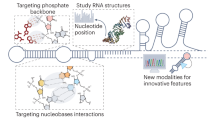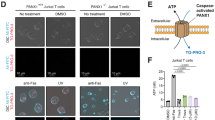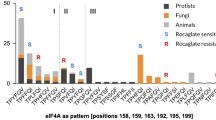Abstract
Shiga-like toxins and ricin are ribosome-inactivating proteins (RIPs) that are lethal to mammals and pose a global health threat. No clinical vaccines or therapeutics currently exist to protect against these RIPs. Two small molecules (Retro-1 and Retro-2) were discovered with high-throughput screening and reported for their protection of cells against RIPs. Of great significance, Retro-2, reported as (E)-2-(((5-methylthiophen-2-yl)methylene)amino)-N-phenylbenzamide, fully protected mice from lethal nasal challenge with ricin. Herein, we report studies showing that the chemical structure of Retro-2 is (±)-2-(5-methylthiophen-2-yl)-3-phenyl-2,3-dihydroquinazolin-4(1H)-one rather than (E)-2-(((5-methylthiophen-2-yl)methylene)amino)-N-phenylbenzamide. The latter is an achiral molecule that converts spontaneously to the former, which is a racemate and showed cell protection against RIPs. This calls for attention to (±)-2-(5-methylthiophen-2-yl)-3-phenyl-2,3-dihydroquinazolin-4(1H)-one as a promising RIP inhibitor and for chemical characterization of drug leads obtained from high-throughput screens.
Similar content being viewed by others
Introduction
Shiga-like toxins (Stx1 and Stx2) produced by certain strains of Escherichia coli are potent ribosome-inactivating proteins (RIPs)1 responsible for outbreaks of foodborne disease with significant morbidity and mortality2. Ricin, produced by the castor plant Ricinus communis, is another potent RIP that has been used for both bioterrorism and the targeted killing of cancerous cells3. No US Food and Drug Administration-approved vaccines or therapeutics currently exist to protect against ricin, Shiga-like toxins, or other RIPs.
Small-molecule inhibitors of ricin and Shiga-like toxins have been sought as potential therapeutics for pre- or post-exposure prophylaxis against RIP poisoning. Two small-molecule structures (Retro-1 and Retro-2; Figure 1) have been discovered with high-throughput screening for their cell protection against RIPs4. Of great significance, Retro-2 at a concentration of 200 mg/kg demonstrated full protection of mice against a dose of ricin that killed 90% of an unprotected control mouse population4.
Using the doorstop approach in search of small-molecule RIP inhibitors that target the catalytic domain of the toxin5, we synthesized Retro-2 as a benchmark and found that the reported achiral Retro-2 structure4 is unstable. Herein, we report our chemical syntheses and cell-based assays showing that the chemical structure of the compound that conferred cell protection activity against RIPs is Retro-2cycl (a racemic mixture; Figure 1). This raises a call for attention to Retro-2cycl as a promising RIP inhibitor and for chemical characterization of small molecules to be used in biological studies.
Results
Chemical structure analysis of Retro-2
Reaction of 2-amino-N-phenylbenzamide with 4-chlorobenzaldehyde in ethanol at room temperature with a catalytic amount of p-toluenesulfonic acid reportedly yielded IA4CL (a close analog of Retro-2; Figure 1)6. No synthetic procedure has been reported for the commercially available Retro-2 and the vendor ChemBridge (San Diego, CA) provided Retro-2 for the reported biological study4. We obtained Retro-2cycl in 60% yield using the same reaction conditions reported for the synthesis of IA4CL and found that these reaction conditions actually produced A4CL (a close analog of Retro-2cycl; Figure 1). Evidence that Retro-2cycl rather than Retro-2 was the reaction product is found in the chemical shifts of two aliphatic carbon atoms (71.38 and 15.63 ppm) in the carbon NMR spectrum of Retro-2cycl because Retro-2 and Retro-2cycl have one and two aliphatic carbon atoms, respectively.
We also found that reacting 2-amino-N-phenylbenzamide with 5-methylthiophene-2-carbaldehyde in acetic acid at room temperature produced Retro-2cycl exclusively in 88% yield. Interestingly, we found that stirring the two reactants in methanol for 1.5 hours at room temperature yielded Retro-2cycl and Retro-2. The latter has a chemical shift of only one aliphatic carbon atom (16.49 ppm) in the carbon NMR spectrum. Our proton NMR spectroscopic study showed that Retro-2 spontaneously converted to Retro-2cycl in neat deuterated methanol over a period of 144 hours, as indicated in Figure 2 by the gradual disappearance of the chemical shifts for the imine proton (8.71 ppm) and the methyl proton (2.59 ppm) of Retro-2 and the gradual and simultaneous appearance of the chemical shifts for the proton at the chiral center (6.26 ppm) and the methyl proton (2.34 ppm) of Retro-2cycl. The half-life of Retro-2 is ~24 hours in neat deuterated methanol (Figure 2). In the presence of a catalytic amount of acid, however, the conversion of Retro-2 to Retro-2cycl was completed within ~30 minutes.
More conclusively, we purchased Retro-2—listed as 2-{[(5-methyl-2-thienyl)methylene]amino}-N-phenylbenzamide with ID 5374762—from ChemBridge and found that the proton and carbon NMR spectra of the product we received were identical to those of Retro-2cycl. These results indicate that Retro-2 is unstable and spontaneously converts to Retro-2cycl.
Cell-based assays of retro-2cycl and A4CL
To investigate whether Retro-2cycl is the actual chemical structure associated with cell protection against RIPs, we tested the cell-protection activities of Retro-2cycl and A4CL using a [35S]-Met-incorporation–based protein synthesis assay in Vero cells. As shown in Figure 3, the presence of 20 μM Retro-2cycl moved the dose-response curve of protein synthesis in the presence of ricin or Stx2 to increased Met incorporation, indicating cell protection by Retro-2cycl against ricin and Stx2. A4CL also showed cell protection against both toxins but was slightly less effective than Retro-2cycl.
Discussion
The conversion of imines to 2,3-dihydroquinazolin-4(1H)-ones is well established in the literature7,8,9,10,11. The erroneous characterization of IA4CL rather than A4CL as the product of the reaction of 2-amino-N-phenylbenzamide with 4-chlorobenzaldehyde in ethanol with a catalytic amount of p-toluenesulfonic acid was, in our view, probably due to the omission of the crucial carbon NMR spectrum6. The abundant literature information on 2,3-dihydroquinazolin-4(1H)-one synthesis and our synthetic work described above show unequivocally that Retro-2 is unstable and spontaneously converts to Retro-2cycl.
Given that the NMR spectra of Retro-2 from ChemBridge, which provided Retro-2 for the reported biological studies4, are identical to those of Retro-2cycl and that Retro-2cycl and its structurally similar analog A4CL protect cells against ricin and Stx2, it is conceivable that Retro-2cycl—which is a racemate—is the compound responsible for the reported biological activities4. In this context, we measured the optical rotations of Retro-2 from ChemBridge and Retro-2cycl and found both to be zero. These results further support our assertion that a racemic mixture of Retro-2cycl produced the reported biological data4.
We have previously reported caveats for the use of chemical screens for potential drug leads5,12. In a reported virtual screen for farnesyltransferase inhibitors12, we found that 6 of 27 compounds purchased from chemical vendors had serious chemical identity or purity issues. In another study of RIP inhibitors5, spectroscopic analyses required to confirm the stereochemistry of two chemicals revealed that the stereochemistry of one had been assigned incorrectly by the vendor. In the Retro-2 report4, of two promising chemical structures discovered with high-throughput screening, one appears to have been incompletely characterized by the chemical vendor. These repeated problems raise concerns and call for chemical characterization of leads identified from high-throughput screens.
Methods
General description of chemical synthesis
All commercially available reagents were used as received. 1H NMR (400 MHz) and 13C NMR (100 MHz) spectra were recorded on a Mercury 400 spectrometer from Varian (Palo Alto, CA). Chemical shifts are reported in ppm using the solvent peak as an internal standard. Data are reported as follows: chemical shift, multiplicity (s = singlet, d = doublet, t = triplet and m = multiplet), coupling constant and integration. Low-resolution mass spectra (LRMS) were recorded using either a Hewlett Packard 5973 Mass Spectrometer with SIS Direct Insertion Probe (Palo Alto, CA) or a Waters ZQ/EMD 1000 Mass Spectrometer (Milford, MA). High-resolution mass spectra (HRMS) were obtained on a Bruker BioTOF II ESI. IR spectra were obtained on a ThermoNicolet Avatar 370 FT-IR (Waltham, MA) using a KBr pellet. A Biotage SP-1 (Charlotte, NC) was used for medium pressure liquid chromatography (MPLC) purification using silica gel as the packing material.
Synthesis of (E)-2-(((5-methylthiophen-2-yl)methylene)amino)-N-phenylbenzamide (Retro-2)
To a stirred solution of 2-amino-N-phenylbenzamide (0.42 g, 2.00 mmol) in methanol (6 mL) at room temperature was added 5-methylthiophene-2-cabaldehyde (214 μL, 2.00 mmol). After 1.5 hours of stirring, the reaction mixture was chilled to −20°C for 1 hour. The resulting yellow short needles were collected via filtration, washed with methanol and dried under high vacuum to give 0.35 g of yellow powder determined to be a 1:1 mixture of Retro-2 and Retro-2cycl using 1H NMR. The filtrate and washings were combined, concentrated in vacuo, purified with MPLC (silica gel, 100% hexanes to 30% EtOAc-hexanes) to give Retro-2 (0.16 g) as yellow viscous syrup and 0.11 g of a 1:1 mixture of Retro-2 and Retro-2cycl. The estimated yields of Retro-2 and Retro-2cycl were 0.39 g (61%) and 0.23 g (36%), respectively. Because Retro-2 (oil) was cyclized spontaneously to Retro-2cycl (solid), the spectral data were collected within 30 minutes after MPLC purification. 1H NMR (400 MHz, CDCl3) δ 11.34 (s, 1H), 8.47 (s, 1H), 8.40 (dd, J = 1.4, 6.6 Hz, 1H), 7.86 (d, J = 8.0 Hz, 2H), 7.58 (d, J = 7.8 Hz, 1H), 7.51−7.47 (m 1H), 7.40−7.33 (m, 3H), 7.15−7.06 (m, 2H), 6.85 (d, J = 3.3 Hz, 1H) and 2.59 (s, 3H); 13C NMR (100 MHz, CDCl3) δ 164.24 (C = O), 154.42 (C = N), 148.95, 148.52, 139.64, 138.95, 135.67, 132.90, 131.84, 129.25, 129.11, 127.57, 126.97, 124.10, 120.82, 118.98 and 16.49; IR (KBr) ν 3463 (w), 3346 (w), 3060 (w), 1659 (m, C = O), 1608 (s, C = N) and 1538 (m) cm−1; LRMS-EI m/z 320 ([M+], 100%); HRMS-ESI m/z 321.1050 ([M+H]+, C19H17N2OS+ requires 321.1062).
Synthesis of 2-(5-methylthiophen-2-yl)-3-phenyl-2,3-dihydroquinazolin-4(1H)-one (Retro-2cycl)
Method 1: To a stirred solution of 2-amino-N-phenylbenzamide (0.10 g, 0.48 mmol) and a few crystals of p-toluenesulfonic acid hydrate in ethanol (3 mL) was added 5-methylthiophene-2-cabaldehyde (56.5 μL, 0.52 mmol) at room temperature. Yellow precipitates appeared in 10 minutes; the color disappeared in 30 minutes. The precipitates were collected via filtration and the filter cake was washed with ethanol and dried under high vacuum to give 0.093 g (60%) of Retro-2cycl as a grey powder. Method 2: To a stirred solution of 2-amino-N-phenylbenzamide (0.21 g, 1.00 mmol) in acetic acid (3 mL) at room temperature was added 5-methylthiophene-2-cabaldehyde (107 μL, 1.00 mmol). Thin-layer chromatography showed completion of the reaction in 20 minutes. The solvent was removed in vacuo and the crude product was purified with MPLC (silica gel, 100% hexanes to 30% EtOAc-hexanes) to give 0.28 g (88%) of Retro-2cycl as a pale yellow solid. The spectral data of Retro-2cycl prepared using methods 1 and 2 were identical. mp 152–154°C; 1H NMR (400 MHz, CDCl3) δ 8.03 (d, J = 7.8 Hz, 1H), 8.02−7.23 (m, 7H), 6.94 (t, J = 7.5 Hz, 1H), 6.70 (d, J = 8.2 Hz, 1H), 6.68 (d, J = 3.5 Hz, 1H), 6.47−6.46 (m, 1H), 6.20 (d, J = 2.3 Hz, 1H), 4.77 (s, 1H) and 2.36 (s, 3H); 13C NMR (100 MHz, CDCl3) δ 162.56 (C = O), 145.14, 141.24, 140.93, 140.71, 134.07, 129.28, 129.25, 127.21, 127.09, 126.82, 124.58, 120.33, 117.50, 115.58, 71.38 and 15.63; IR (KBr) ν 3289 (m, N-H), 1637 (s, C = O), 1611 (w), 1505 (m), 1486 (m) and 1387 (m) cm−1; LRMS-EI m/z 320 ([M+], 100%); HRMS-ESI m/z 321.1046 ([M+H]+, C19H17N2OS+ requires 321.1062). Anal. cald for C19H16N2OS 0.5 H2O: C, 69.28; H, 5.20; N, 8.50. Found: C, 69.43; H, 5.23; N, 8.61.</title>
Conversion experiment of Retro-2 to Retro-2cycl
A small amount (~2 mg) of Retro-2 was dissolved in CD3OD (1.5 mL) and 1H NMR spectra were taken every 12 hours. The half-life of Retro-2 to Retro-2cycl was ~24 hours at room temperature in CD3OD.
[35S]-Methionine incorporation assay
Vero cells were maintained in Dulbecco's modified Eagle medium with 10% fetal calf serum and 1 mM glutamine. The cells were resuspended after trypsin treatment at 4×104 cells/mL in the same medium and 0.5 mL of the medium was dispensed into 24-well plates. After 24 hours at 37°C and 5% CO2, the medium was changed to Dulbecco's modified Eagle medium without Met, Gln, or fetal calf serum and equilibrated for 1 hour. An inhibitor solution with a final dimethyl sulfoxide concentration of 0.5% was added to the medium at 25 hours. Ricin or Stx2 was added after 26 hours at varied concentrations. [35S]-Met was added 2 hours after ricin exposure or 3 hours after Stx2 exposure. The [35S]-Met incorporation was terminated 30 minutes after the Met addition via medium removal and addition of 150 μL of 0.2 M KOH to dissolve cells, as described elsewhere13. Proteins were precipitated with 10% trichloroacetic acid, harvested on glass fiber filters and counted. The control incorporation was determined after treatment with 0.5% dimethyl sulfoxide alone. Ricin was purchased from Vector Laboratories (Burlingame, CA). Stx2 was provided by the Phoenix Laboratory (Tufts-NEMC Microbial Products & Services Facility).
References
Johannes, L. & Römer, W. Shiga toxins--from cell biology to biomedical applications. Nat Rev Microbiol 8, 105–116 (2010).
Snedeker, K. G., Shaw, D. J., Locking, M. E. & Prescott, R. J. Primary and secondary cases in Escherichia coli O157 outbreaks: a statistical analysis. BMC Infect Dis 9, 144 (2009).
Audi, J., Belson, M., Patel, M., Schier, J. & Osterloh, J. Ricin poisoning: a comprehensive review. JAMA 294, 2342–2351 (2005).
Stechmann, B. et al. Inhibition of retrograde transport protects mice from lethal ricin challenge. Cell 141, 231–242 (2010).
Pang, Y.-P. et al. Small-molecule inhibitor leads of ribosome-inactivating proteins developed using the doorstop approach. PLoS One 6, e17883 (2011).
Liang, Y., Su, B., Zhao, J. & Sun, W. The synthesis of new asymmetric double shiff bases containing a new O-amino benzoic acid derivative. Synth. Commun. 34, 3235–3242 (2004).
Wang, L.-M., Hu, L., Shao, J.-H., Yu, J. & Zhang, L. A novel catalyst zinc(II) perfluorooctanoate [Zn(PFO)2]-catalyzed three-component one-pot reaction: synthesis of quinazolinone derivatives in aqueous micellar media. J. Fluorine Chem. 129, 1139–1145 (2008).
Hisano, T., Ichikawa, M., Nakagawa, A. & Tsuji, M. Studies on organosulfur compounds XII: syntheses and pharmacological activities of 2-heterocyclic substituted 4(3H)-quinazolinones. Chem. Pharm. Bull. 23, 1910–1916 (1975).
Sattarova, O. E., Vizgunova, O. L. & Voronina, E. V. Synthesis and antimicrobial activity of 1,2-diaryl- and 2,3-diaryl-(2-aryl-3-N-arylamino)-1,2,3,4-tetrahydroquinazolin-4-ones. Pharm. Chem. J. 40, 73–75 (2006).
Zhang, G. et al. Synthesis and crystal structure of a new quinazolinone compound 2,3-dihydro-2-(2-hydroxyphenyl)-3-phenyl-quinazolin-4(1H)-one. Chinese J. Struct. Chem. 24, 783–788 (2005).
Sattarova, D. E., Kozhevnikov, Y. V., Zalesov, V. S. & Nikulina, S. N. Synthesis and biological activity of novel derivatives of 1,2,3,4-tetrahydroquinazolin-4-one. Khim.-Farm. Zh. 18, 1208–1210 (1984).
Perola, E. et al. Successful virtual screening of a chemical database for farnesyltransferase inhibitor leads. J. Med. Chem. 43, 401–408 (2000).
Jacewicz, M., Feldman, H. A., Donohue-Rolfe, A., Balasubramanian, K. A. & Keusch, G. T. Pathogenesis of Shigella diarrhea. XIV. Analysis of Shiga toxin receptors on cloned HeLa cells. J. Infect. Dis. 159, 881–889 (1989).
Acknowledgements
This work was supported by the U.S. National Institute of Allergy and Infectious Diseases (1U01AI082120-01). We acknowledge Dr. Dengfeng Dou of the Computer-Aided Molecular Design Laboratory for developing a procedure to prepare Figure 2 in PDF using the MestReNov 7 program (Mestrelab Research, Spain).
Author information
Authors and Affiliations
Contributions
J.G.P. discovered the conversion of Retro-2 to Retro-2cycl; Y.-P.P., J.G.P. and N.E.T. designed the experiments; J.G.P. and J.N.K. performed the experiments; all authors analyzed the data; Y.-P.P. wrote the paper; all authors contributed with revisions.
Ethics declarations
Competing interests
The authors declare no competing financial interests.
Rights and permissions
This work is licensed under a Creative Commons Attribution-NonCommercial-ShareALike 3.0 Unported License. To view a copy of this license, visit http://creativecommons.org/licenses/by-nc-sa/3.0/
About this article
Cite this article
Park, J., Kahn, J., Tumer, N. et al. Chemical Structure of Retro-2, a Compound That Protects Cells against Ribosome-Inactivating Proteins. Sci Rep 2, 631 (2012). https://doi.org/10.1038/srep00631
Received:
Accepted:
Published:
DOI: https://doi.org/10.1038/srep00631
This article is cited by
-
Halting ErbB-2 isoforms retrograde transport to the nucleus as a new theragnostic approach for triple-negative breast cancer
Cell Death & Disease (2022)
-
JC polyomavirus attachment, entry, and trafficking: unlocking the keys to a fatal infection
Journal of NeuroVirology (2015)
-
Artificial photosynthesis of oxalate and oxalate-based polymer by a photovoltaic reactor
Scientific Reports (2014)
-
Common Pharmacophore of Structurally Distinct Small-Molecule Inhibitors of Intracellular Retrograde Trafficking of Ribosome Inactivating Proteins
Scientific Reports (2013)
-
Retrograde transport of protein toxins through the Golgi apparatus
Histochemistry and Cell Biology (2013)
Comments
By submitting a comment you agree to abide by our Terms and Community Guidelines. If you find something abusive or that does not comply with our terms or guidelines please flag it as inappropriate.






